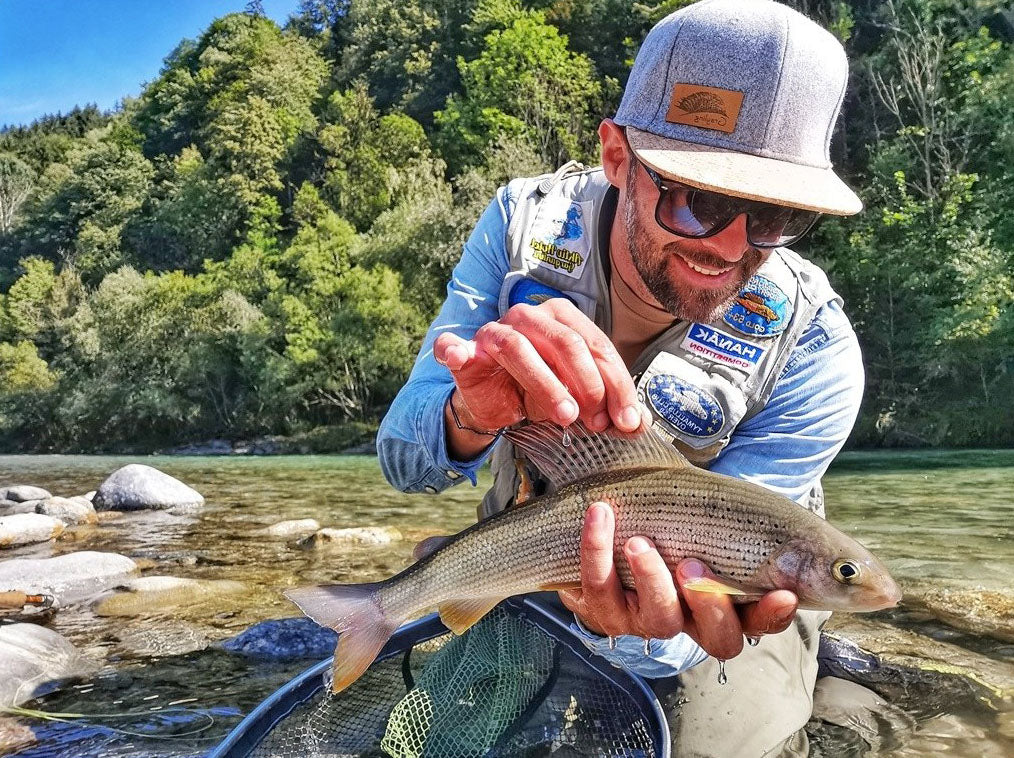The end of summer is now near, the brightness is changing, the air becomes crisper, and we can smell that typical autumn scent. Suddenly, we are filled with a sense of melancholy, sadness, or something else, a feeling that something is coming to an end. Yet at the same time, we also feel a sense of relief, curiosity, a desire for tranquility, a wish to immerse ourselves in nature, enjoy the coolness, and take advantage of the calmness of the great rivers, along with that urge for grayling...
For us, afflicted by acute grayling fever, this is the long-awaited period, our magical moment. Streams that are unfishable for much of the year are now finally accessible. Unfortunately, with the advent of climate change over the past decades, some of the best rivers for grayling are only suitable for fly fishing for a couple of months each year, mainly in autumn.

The gradual decrease in temperatures and the reduction of storm events allow the rivers to find a certain regularity; the levels return to low, and the water temperature becomes more stable. This series of phenomena, combined with good weather conditions, creates the ideal circumstances for our beloved insect hatches.
Unfortunately, insect hatches are becoming increasingly rare, and the rivers are offering less and less benthic fauna. In recent years, I have noticed a drastic decline in these events, not only in the areas where I fish in southern Austria but also on a general level. Even though the water quality has improved in some rivers, the insects have nearly disappeared.

Multiple factors have contributed to these changes. In my opinion, the three main points are: the presence of dams and the resulting clogging of the riverbed due to fine silt that settles on the bottom, “cementing” all the gaps between the stones and pebbles, leading to a lack of light, oxygen, and food for the larvae; the lowering of water temperatures due to increased glacial melt; and the "purity" of the water. Indeed, with the advent of water treatment plants, rivers no longer receive the organic nourishment that is vital for our benthic fauna. Pollution, especially in my area, is no longer considered a determining cause of these phenomena.
Nevertheless, nature somehow always manages to resist and continually surprises us. In fact, despite all these factors, increasingly violent floods, and everything else, there are still corners of the river where we can find healthy and rich habitats, where larvae find ideal conditions to complete their life cycles and provide us, but especially our fish friends, with spectacular hatches.
THE SEASON FOR FISHING IN THE LARGE RIVERS
If during most of the season we are forced to fish with nymphs or even not fish at all, autumn opens up multiple possibilities for us. As temperatures gradually cool, river levels stabilize, and the large valley rivers, home to the biggest and most elusive graylings, become accessible again. It is always nice to return after months of absence; we can define it as a sort of second opening of the fishing season. Indeed, some spots “rest” during the summer months, and after months of high, muddy water, surprises are always around the corner. The various floods that characterize any large river redistribute the fish across all areas of the river and sometimes change its course, creating new spots, new holes, new gravel beds, etc.

OCTOBER, THE MONTH OF THE DRY FLY
After the floods and various dry spells, and with the gradual decrease in snowmelt and glacial runoff, the riverbeds begin to repopulate with benthic fauna. The caddis or stonefly larvae that hatched during the summer months gradually give way to mayfly larvae of the genus Baetis. In fact, this type of larvae is always present, but during the summer months, we hardly notice them, either due to the presence of numerous other insects or their small size when they hatch. In the autumn, the size of the flies increases, and every day, regularly around lunchtime, we can witness the spectacle of the hatch.
Generally, in the rivers I frequent, such as the Drava or the Möll, I notice that hatches always occur during the central hours of the day, in the warmest hours. The first "sub-imagines" carried by the current become noticeable towards late morning and gradually increase, reaching a peak a couple of hours later when, at the end of the hatch, the water surface fills with "spents." During this time, the river, which previously appeared calm and almost lifeless, finally comes to life. At first, some birds skim the water surface, scooping up the mayflies that, still sluggish due to the low water temperature, struggle to detach from the surface film. Then the first fish, usually young graylings—small but already very aggressive—start rising vigorously, concealing their presence, usually in the shallows or in the currents at the margins of the main flow.
Of course, one must be ready to take advantage of this favorable moment, as you never know how long it will last; it can last a couple of hours or just a few minutes. It largely depends on the weather conditions. Generally, the ideal scenario is cloudy weather with low pressure, without wind or even with a light rain; sun and wind are the number one enemies for a good hatch and subsequent fishing. I've often experienced beautiful hatches under a blazing sun and heat, but without any rises.
But now let’s return to the principle of hatching. The young graylings are fun and continue their surface feeding phase, which is a good time to figure out the best flies to use in anticipation of the peak moment of the hatch. Numerous fishing outings have made me realize that there is never a fly that works all the time, especially with graylings. Every time, you need to find the right imitation. I believe this is also one of the reasons why I am crazy about grayling fishing.
After this training, you finally start to hear some slurps—the dull sucking sound that characterizes the rise of big graylings is music to our ears. It's always better to pay close attention to the sounds and noises of the river; sometimes the rises, especially those far away, are imperceptible to the eye, but if we pay attention, even the simplest sound can help us locate a big grayling rising. Once located, numerous factors come into play; seeing it doesn’t mean catching it. The cast must be perfect, you need a lot of patience, and the line must be long enough to allow us to change flies. Finally, the timing of the rise and hook set must be perfect, like a skilled marksman.

A WIDE RANGE OF IMITATIONS
In my selection of flies that I always have on hand, the top spots go to emergers tied with partridge or hen hackle, which work exceptionally well during the initial stages of the hatch. Sometimes, especially when I’m fishing at long distances and where the use of two flies is allowed, I pair a dry fly, such as a parachute, tied on a leader of 15/20 cm, with an emerging fly that floats about thirty centimeters below the water's surface. This is a deadly technique, especially at long distances, when fishing with subsurface flies becomes more complicated. In fact, the dry fly serves a dual purpose as both a fishing fly and an indicator.
I really enjoy subsurface fishing, but one thing that bothers me is not seeing the grayling take, which often happens just below the surface. Especially at long distances and with small flies, it can be very hard to see, sometimes resulting in having to retrieve the fly from the fish's throat. Although some may consider fishing with two flies to be less “ethical” compared to traditional dry fly fishing, for me, the respect for the fish comes first and foremost.
The lower sections of my fly box are filled with a wide variety of mayfly imitations of all sizes and colors, mayflies that allow me to fish through all stages of the hatch: subimago, imago, and some spent. Of course, I always have a few stray flies to fish "out of hatch," including small sedges, stoneflies, and flying ants.

Unfortunately, as often happens in life, beautiful things don’t last long, and that's how it should be. It's up to each angler's skill to take advantage of every favorable moment and, of course, to be prepared to be in the right place at the right time.
Autumn is just around the corner. After a summer spent tying flies, my fly boxes are overflowing with flies ready to be cast for my beloved graylings in the Drava!




Teilen:
Choosing the cane by Franta Hanák
Grayling Fishing – If it’s not a grayling from the Drava, it’s just a grayling...